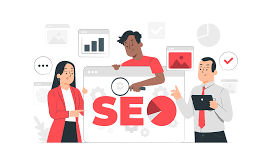In a world where every click counts, it’s easy to overlook the small details that make a massive difference in your website’s performance. You’ve got great content, a stunning design, and a solid marketing plan, but without on-page SEO, it’s like shouting into a void. The truth is, without the right optimization, your website could be buried, unnoticed, in the vast ocean of the internet. But here’s the good news: it doesn’t have to stay that way. Your website can go from invisible to indispensable with a few strategic on-page SEO tweaks.
Why Does On-Page SEO Matter?
SEO is a vital component of your website’s growth strategy. You’re essentially putting a block on your content’s potential without it. The way you structure your pages, the way you use keywords, and how you optimize the user experience all play a role in determining whether or not your site ranks well.
Let’s say, for instance, you’ve spent hours perfecting a product page, writing compelling content, and designing a sleek layout. But if you haven’t optimized it for SEO, you’re setting yourself up for disappointment. Search engines may ignore your page, or worse, bury it under pages that are optimized.
Optimize Page Titles and Meta Descriptions
One of the most powerful aspects of on-page SEO services lies in the title tags and meta descriptions. These elements not only help search engines understand what your page is about, but they also play a key role in enticing users to click.
Page Titles
Ensure your page titles are concise, clear, and include your primary keyword. If your page is about SEO services, use titles like “Effective On-Page SEO Services to Boost Your Website Ranking” or something specific to your offering.
Meta Descriptions
Meta descriptions are often the first thing users see when your page appears in search results. Make sure these are engaging and informative. Avoid stuffing keywords, but try to incorporate them naturally. You want to give users a reason to click.
Best Practices:
- Keep titles under 60 characters.
- Write compelling meta descriptions that entice users (under 160 characters).
- Use relevant keywords but avoid overuse.
Header Tags: A Structure for SEO Success
Header tags (H1, H2, H3, etc.) are more than just tools for formatting. They help break up your content into digestible chunks for readers and also send signals to search engines about the importance of various sections.
H1 Tag
Only one H1 tag per page should be used. This is your page’s main heading, and it should clearly reflect what the page is about. Typically, your H1 tag will contain your primary keyword.
H2 and H3 Tags
These subheadings further break down your content. They should help structure the content in a way that is easy for both readers and search engines to navigate.
Best Practices:
- Use H1 only once on the page.
- Break content into smaller, easily scannable sections using H2 and H3 tags.
- Include secondary keywords where appropriate.
Content Is King – But It’s the Quality That Counts
Content is at the core of on page SEO services. However, simply adding more content isn’t enough. Your content must be valuable, relevant, and optimized for both search engines and your audience.
Focus on User Intent
Search engines are prioritizing user intent more than ever. If your content doesn’t match what users are searching for, it won’t rank. Try to think from the perspective of the user—what do they want to know, and how can your content provide the best answer?
Keyword Optimization
Avoid keyword stuffing, which only serves to harm your rankings. Focus on relevant long-tail keywords and make sure they appear naturally throughout your content.
Content Length
Longer content tends to rank better, but quality matters more than quantity. Aim to provide the most comprehensive answer possible while maintaining engagement.
Best Practices:
- Write for your audience, not for search engines.
- Include your target keywords in a natural way.
- Provide long-form content that is useful, insightful, and relevant.
The Power of Internal Linking
Internal linking plays a crucial role in improving your website’s SEO performance. Links to other pages within your site provide search engines with a roadmap to crawl and index your content more effectively.
Relevance is Key
Don’t link to pages just for the sake of it. The links should be relevant and add value to the user’s experience. The more relevant your internal links are, the better your SEO results.
Anchor Text
Use descriptive anchor text that gives users and search engines a sense of what the linked page is about. Avoid using generic text like “click here.”
Best Practices:
- Include internal links to related articles, services, or products.
- Use keyword-rich anchor text to help with ranking.
Mobile Optimization: Don’t Ignore It
More than half of web traffic comes from mobile devices. If your website isn’t optimized for mobile users, you’re missing out on a massive chunk of potential traffic. Plus, Google’s mobile-first indexing means that if your mobile site isn’t up to par, it could hurt your rankings.
Responsive Design
Make sure your site is responsive. This means that it should adjust to any screen size without breaking the layout.
Page Speed
Mobile users expect fast-loading pages. Slow load times lead to high bounce rates, which can negatively impact your rankings. Optimize images, use caching, and ensure your site loads as quickly as possible.
Best Practices:
- Ensure your site is mobile-friendly with a responsive design.
- Compress images and reduce page load times to enhance the mobile experience.
Image Optimization for Faster Loading Times
Images are a key part of your content but can also be a major factor in slowing down your website if not optimized. Search engines favor faster-loading pages, and users prefer websites that load quickly.
Compression
Before uploading images to your site, ensure they are compressed without losing quality. This will help reduce load times significantly.
Alt Text
Search engines can’t “see” images, but they can read alt text. By adding descriptive alt text, you not only improve your SEO but also make your content more accessible.
Best Practices:
- Compress images without sacrificing quality.
- Include descriptive alt text with relevant keywords.
URL Structure: Simple, Clean, and Descriptive
A clear URL structure makes it easier for search engines to understand what the page is about and also improves the user experience.
Short and Descriptive
Keep your URLs short and relevant. Avoid long, complex URLs with unnecessary parameters. Include your target keyword, but don’t overdo it.
Avoid Special Characters
Special characters like question marks, ampersands, and percent signs can confuse search engines and users alike. Stick to simple, readable URLs.
Best Practices:
- Use short, clear, and descriptive URLs.
- Include relevant keywords where possible.
- Avoid unnecessary characters and parameters.
Schema Markup: Help Search Engines Understand Your Content
Schema markup is code that you can add to your website to help search engines understand the context of your content. When done right, schema markup can lead to rich snippets, which can boost click-through rates and visibility in search results.
Types of Schema Markup
From product pages to events to reviews, there are different types of schema markup that can be used. Select the one that best matches the content of your page to improve how it appears in search results.
Best Practices:
- Implement relevant schema markup for your content type.
- Test your schema using Google’s Structured Data Testing Tool.
User Experience (UX) Optimization: More Than Just a Trend
On-page SEO isn’t just about keywords and technicalities—it’s also about how users interact with your site. A smooth, engaging user experience encourages users to stay longer and engage more with your content.
Navigation
Make it easy for users to find what they’re looking for. A cluttered, confusing navigation system will only lead to frustration and increased bounce rates.
Clear CTAs
Your calls to action (CTAs) should be clear, direct, and strategically placed. A CTA that stands out can make the difference between a visitor leaving your site or becoming a customer.
Best Practices:
- Ensure your site’s navigation is simple and user-friendly.
- Place CTAs where they’re easy to see but not intrusive.
The Road to SEO Success
It’s not about ticking off boxes or following trends but it’s about ensuring your site provides real value to users while being easy to find and navigate. As you fine-tune your on-page SEO, keep in mind that every improvement brings you one step closer to achieving better rankings and greater engagement. The road to better SEO might not always be easy, but with the right strategies in place, you’ll see real, sustainable growth in your website’s performance. Want to see real results? Senotrix can help you optimize your on-page SEO and ensure your website gets the attention it deserves. Let’s make sure your site stands out. Contact us today and start driving more traffic!
 The Random Collective Where Curiosity Meets Creativity
The Random Collective Where Curiosity Meets Creativity





